Text-to-Speech (TTS) technology converts written text into natural, human-like speech, enabling devices to communicate verbally with users.
In virtual assistants, TTS plays a crucial role by providing clear, engaging responses that make interactions seamless and intuitive. By transforming information into spoken words, TTS enhances accessibility, keeps users informed hands-free, and creates a more personalized experience.
This technology allows virtual assistants to sound natural, responsive, and conversational, improving overall user satisfaction and making everyday tasks, from setting reminders to fetching information, simpler and more enjoyable.
How TTS Works in Virtual Assistants
Text-to-Speech (TTS) in virtual assistants converts written text into natural-sounding speech that users can hear instantly. The system first processes the text, breaking it into sentences and understanding context, tone, and emphasis.
AI-powered TTS engines then generate human-like voices with smooth intonation and pronunciation. These voices are designed to sound friendly, clear, and natural, creating a conversational experience.
TTS works closely with speech recognition and AI engines, allowing the assistant to understand user commands, process them, and respond immediately. This seamless integration ensures smooth, real-time interaction, making virtual assistants feel more engaging, intelligent, and human-like while handling various tasks efficiently.
Key Uses of TTS in Virtual Assistants
- Real-time information delivery
- Personalized user interactions
- Supporting multiple languages and accents
- Accessibility for visually impaired or reading-challenged users
- Streamlining customer service and support
Benefits of Using TTS for Virtual Assistants
Enhanced engagement and user satisfaction: Text-to-Speech (TTS) creates natural, human-like interactions that keep users engaged and improve overall satisfaction.
Consistent and reliable voice responses: TTS ensures every response is clear, uniform, and free from variations, providing dependable communication.
Scalability for handling multiple requests: Virtual assistants powered by TTS can respond to countless users simultaneously without delays.
Reducing operational costs: TTS minimizes the need for large human support teams, lowering expenses while maintaining high service quality.
Implementing TTS in Virtual Assistant Systems

Implementing TTS in virtual assistant systems enhances user experience by making interactions more natural and engaging. Choosing high-quality TTS voices is essential, and platforms like Speechactors offer clear, human-like voices that fit various brand tones.
Configuring natural intonation and clarity ensures that the assistant speaks smoothly, with proper pauses, emphasis, and pronunciation, making conversations feel realistic. Integrating TTS with existing platforms and apps allows seamless communication across devices, including mobile, web, and smart home systems.
This setup helps virtual assistants respond instantly, maintain consistent voice quality, and engage users more effectively, creating a professional and interactive digital assistant experience.
Challenges and Solutions
Challenges and Solutions in text-to-speech systems focus on creating a natural, smooth, and engaging experience for users. Avoiding robotic or unnatural voice outputs is key, as lifelike tones make conversations feel real and personal.
Ensuring fast and accurate responses helps users get the information they need instantly, keeping interactions seamless and satisfying. Managing multiple languages and dialects allows platforms to reach a wider audience, providing consistent communication across cultures.
Maintaining user trust and engagement is essential, as clear, expressive, and human-like voices encourage longer interactions and repeated use. Together, these solutions make TTS systems more effective, enjoyable, and user-friendly.
Future Trends in TTS for Virtual Assistants
The future of Text-to-Speech (TTS) technology in virtual assistants is evolving rapidly, introducing more personalized and human-like interactions. AI-driven voice personalization allows virtual assistants to adapt their tone, pitch, and style based on user preferences, creating a more engaging experience.
Emotional intonation is becoming increasingly sophisticated, enabling assistants to recognize and respond to the user’s emotional state, enhancing empathy and understanding. Furthermore, the expansion of multilingual and regional language support ensures that virtual assistants can communicate effectively with a global audience, breaking down language barriers.
Predictive and proactive voice responses are also on the rise, with assistants anticipating user needs and providing information or assistance before being asked, streamlining interactions and improving efficiency. These advancements are transforming virtual assistants into more intuitive and responsive companions in our daily lives.
Frequently Asked Questions (FAQs)
How does TTS improve virtual assistant performance?
TTS enhances virtual assistants by providing clear, natural-sounding speech, increasing user engagement, reducing response time, and supporting accessibility for users with visual or reading difficulties.
Can TTS voices be customized for brands?
Yes, TTS voices can be tailored with unique tone, style, and pronunciation, helping brands maintain consistent identity across marketing, apps, and customer interactions.
Does TTS work across multiple platforms and devices?
TTS operates seamlessly on smartphones, tablets, desktops, smart speakers, and web applications, ensuring consistent voice experiences for users anywhere, anytime.
How many languages and accents does Speechactors support?
Speechactors offers dozens of languages and accents, covering English variants, regional languages, and global dialects to engage diverse audiences effectively.
Is TTS suitable for high-traffic customer service applications?
TTS is ideal for high-traffic environments, delivering fast, reliable, and scalable voice responses while maintaining consistency and enhancing customer satisfaction.
Conclusion
Text-to-speech technology transforms virtual assistants into engaging, accessible, and efficient tools, enhancing user experience with natural, clear, and dynamic voice interactions.
By enabling multilingual support, consistent communication, and personalized responses, TTS helps virtual assistants connect more deeply with users.
Integrating high-quality TTS solutions like Speechactors allows businesses to elevate their virtual assistant capabilities while saving time and resources. Explore Speechactors today to bring your virtual assistant to life with lifelike voices and seamless interactions, and experience the future of intelligent, human-like communication.
